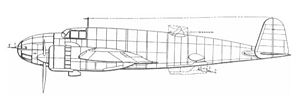PZL.49 Mis Video - Picture

|
|
PZL.49 Mis
PZL.49 Mis

Picture - Possibly a side drawing from one of the few surviving pieces of documentation on this design.
Role: Bomber
Manufacturer: PZL
Primary user: Polish Air Force (planned)
Number built: Incomplete prototype
Developed from: PZL.37 ĊoĊ
The PZL.49 Mis (Polish: teddy-bear) was a Polish twin-engined medium bomber design that remained only a project due to the outbreak of World War II.
Design
The PZL.49 was a development of the advanced, "state-of-the-art" medium bomber PZL.37 ĊoĊ, designed by Jerzy DÄ browski, StanisĊaw Kot and Piotr Kubicki. About 50% of its design elements were taken from PZL.37 ĊoĊ bomber to simplify the design process. The main target for the design team was to increase performance, especially flight speed, by means of installing more powerful engines and improving aerodynamics. Its standard 2,200 kg (4,900 lb) bomb load could be increased to 3,000 kg (6,600 lb) by decreasing its fuel load. Its standard 2,200 km (1,200 nmi) range could be increased to 3,000 km (1,900 nmi) with additional fuel tanks.
Detailed project was ready in mid-1938 and a report by General Jx³zef ZajÄ c from 28 November, 1938 stated that all drawings were complete. Design process was slow due to the simultaneous involvement of PZL construction bureau in development of the PZL.50 JastrzÄ b fighter. During the summer of 1939, a mock-up of the PZL.49 was approved by the Air Force and project could be continued. Due to the engagement of Jerzy DÄ browski in PZL.62 development, Piotr Kubicki became the leader of the PZL.49 design team.
In late 1938 or early 1939 production of parts for two prototypes begun in Wytwx³rnia PĊatowcx³w nr 1 of PZL factory (PZL WP-2). In early 1939 a full scale mock-up of fuselage with part of the left wing was built for testing placement of cockpit and fuselage equipment.
Serial production was planned to take place in the PZL WP-2 factory in Mielec as well as construction bureau HQ. A development schedule from August 1939 set the first flight of PZL.49/I in the summer of 1940, with the first serial built aircraft being delivered to combat units in late 1941 or early 1942. However, due to the German invasion on 1 September 1939, all plans were canceled. All documentation of the PZL.49 project was moved to Jerzy DÄ browski's apartment in Warsaw early September 1939 and in late September, during siege of Warsaw, was burned in a nearby bakery to avoid German capture. Very little of the documentation has been recovered since the war.
Technical design
The aircraft was conventional in layout, all metal (including the skin), with low-set laminar-flow wings and a twin tail. In terms of size, it was slightly larger than the Lockheed Model 10 Electra that Amelia Earhart used and was comparable to its predecessor, the PZL.37 ĊoĊ. The crew consisted of four: pilot, commander/bombardier, radio operator and a rear gunner. The bombardier was accommodated in the glazed nose, with two forward-firing 7.92 mm PWU wz.37 machine guns. The radio operator sat inside the fuselage, above the bomb bay. The radio operator also operated two rear-firing 7.92 mm PWU wz.37 machine guns fitted in a koĊyska (Polish: bassinet, typically called a gondola in English). The rear gunner sat in a fuselage turret with a 20mm cannon or four 7.92 mm PWU wz.37 machine guns.
The main undercarriage retracted into the engine nacelles. The undercarriage was double-wheeled, with an independent suspension for each wheel and retractable rear wheel. The plane was powered by two Bristol Hercules radial engines with NACA covers. The bombs were carried in a two-section bomb bay in the fuselage, as well as bomb bays in the central section of the wings. The maximum load was 3,000 kg. Wings were fitted with split flaps.
Variants (planned)
PZL.49/I First prototype for flight and static trials. PZL.49/I Second prototype, pattern aircraft for PZL.49A version. PZL.49A Version powered by PZL-Bristol "Hercules" III engines. PZL.49B Export version with French Gnx´me-Rhx´ne 14N-50/51 engines.
Operators (planned)
Poland
Polish Air Force
Brygada Bombowa
Specification
Performance below are expected figures.
General characteristics
Crew: 4, pilot/navigator, observer/bombardier/forward gunner, radio operator/rear gunner, rear gunner
Length: about 14.50 m (sources also claim 14.30 m and 14.40 m) ()
Wingspan: about 18.00 m (sources claim between 17.93 m and 18.20 m) ()
Height: 4.80 m ()
Wing area: about 55 m² (sources also claim 53 m² and 53.5 m²) (ft²)
Empty weight: 6,250 kg / 6,500 kg ()
Useful load: 5,000 kg / 5,250 kg ()
Max takeoff weight: 11,500 kg ()
Powerplant: 2x PZL-Bristol "Hercules" III air-cooled 14-cylinder radial engine, 1290 hp (950 kW) each
Performance
Maximum speed: 520 km/h
Range: 2,200 km (max. 3,000 km) ()
Wing loading: 209 kg/m² ()
Armament
2 x 7.92 mm PWU wz.37 machine guns in nose
2 x 7.92 mm PWU wz.37 machine guns mounted in ventral position
1 x 20 mm Oerlikon FF S or FK wz.38D cannon, or 4 x 7.92 mm PWU wz.37 machine guns in dorsal turret
Max. 3000 kg bombs
Andrzej Glass: "Polskie konstrukcje lotnicze 1893-1939" (Polish aviation constructions 1893-1939), WKiĊ, Warsaw 1977 (Polish language, no ISBN)
Related development
PZL.37 ĊoĊ
Comparable aircraft
Handley Page Hampden
Heinkel He 111
Dornier Do 17
Ilyushin Il-4
PZL.49 Mis Pictures and PZL.49 Mis for Sale.
Living Warbirds: The best warbirds DVD series.
Source: WikiPedia